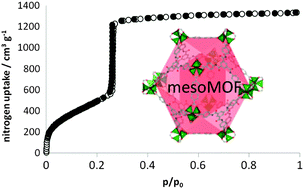Ultrahigh porosity in mesoporous MOFs: promises and limitations
Abstract
Mesoporous MOFs are currently record holders in terms of the specific surface area with values exceeding 7000 m2 g−1, a textural feature unattained by traditional porous solids such as zeolites, carbons and even by graphene. They are promising candidates for high pressure gas storage and also for conversion or separation of larger molecules, whose size exceeds the pore size of zeolites. The rational strategies for synthesis of mesoporous MOF are outlined and the unambiguous consistent assessment of the surface area of such ultrahighly porous materials, as well as present challenges in the exciting research field, of mesoporous MOFs are discussed. The crystallinity, dynamic properties, functional groups, and wide range tunability render these materials as exceptional solids, but for the implementation in functional devices and even in industrial processes several aspects and effective characteristics (such as volumetric storage capacities, recyclability, mechanical and chemical stability, activation) should be addressed.


 Please wait while we load your content...
Please wait while we load your content...